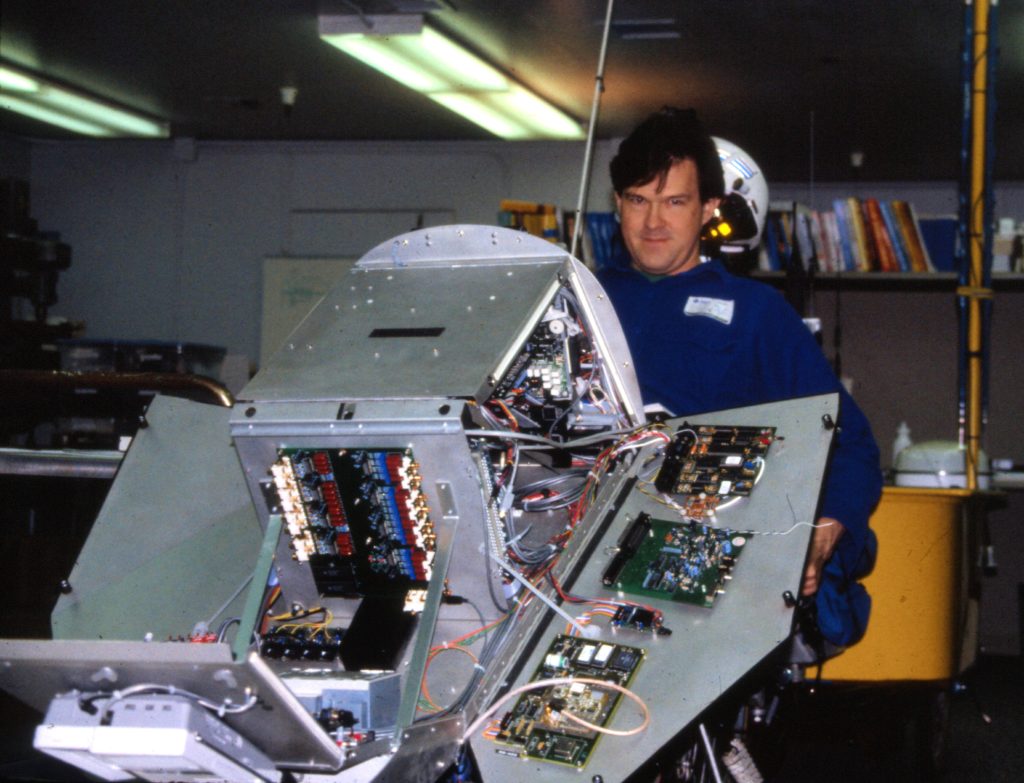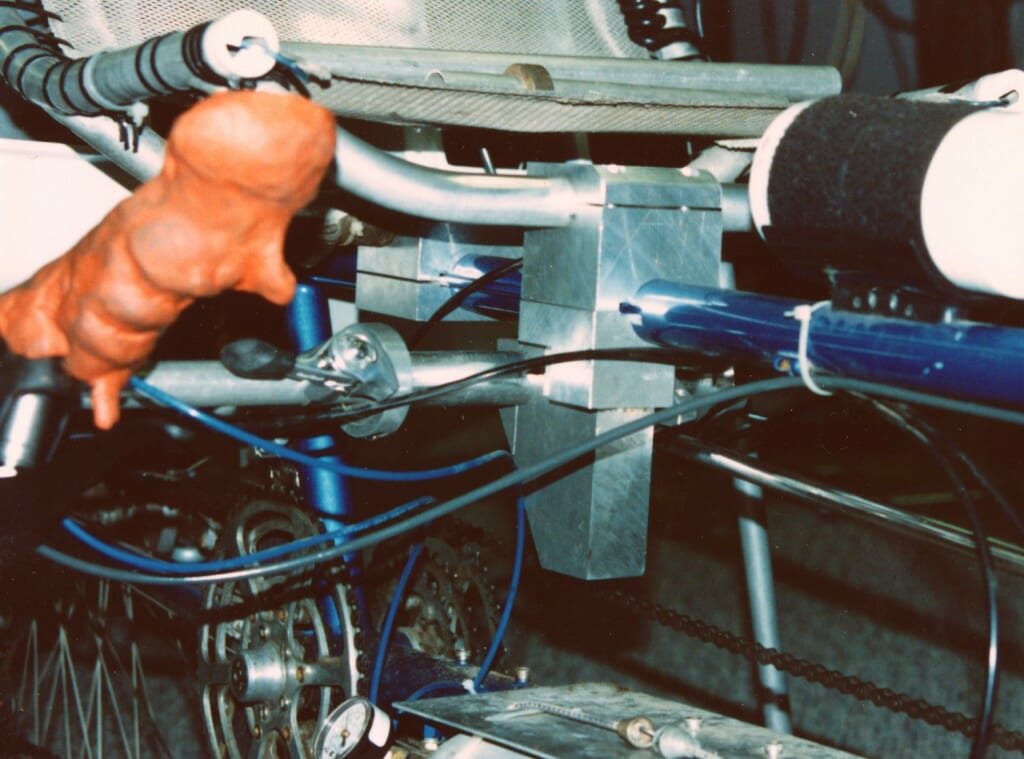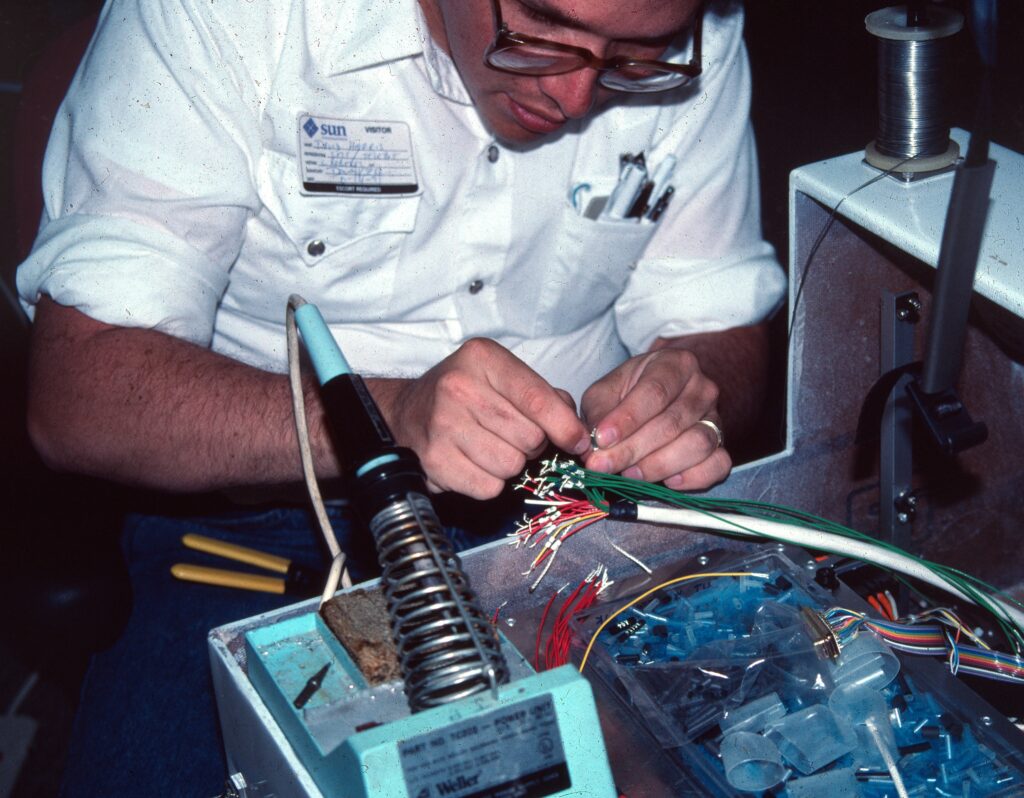
Bikelab Report #6 – Various BEHEMOTH Tech Details
This is an intense time. Overload is a common theme: the bike, that perennial focus of attention supported by sponsorship and publicity, sits mostly idle while I work full time on sponsorship and publicity. It is a terrible thing to be finite. Progress is occurring on many fronts, but only a few of them result in physical changes to the machine.
Some of those fronts are pretty interesting, though… and in this report I want to bring you up to date on a variety of items. I believe the fellow in the photo above is Mike Perry, the FORTH language wizard who helped with bicycle control processor code at about this time.
Bikelab Notes #6
January 30, 1991
by Steven K. Roberts
“…as we enjoy great advantages from the inventions of others, we should be glad of an opportunity to serve others by any invention of our own, and this we should do freely and generously.”
— BENJAMIN FRANKLIN, UPON REFUSING A PATENT OFFERED BY THE GOVERNOR OF PENNSYLVANIA FOR HIS STOVE.
Handlebars
First, you may recall from Bikelab Report #3 the mail discussion about steering. The question there was whether to stick with the straight bar under the seat or go to a much more elaborate (and comfortable, probably) assembly that would be more like tank controls — with an articulated linkage of shafts and bell cranks to couple arm motion to a pair of opposing push rods. The primary motive was ergonomic, eliminating all twists of the wrists while adding more hand grip real estate for controls, and it also offered elevated WQ (Weirdness Quotient) at no extra charge.
After having nightmares about the dynamics of emergency braking on bumpy roads and other risky situations, we’re now back to a simpler system. Dave Berkstresser has completed the mechanical design, and the aluminum stock and necessary end mills are in house. Basically, this is an extension of the original under-seat steering… but done right. Hand grips will be removable for service, and mount into the tube with expansion bolts such that they form about a 45-degree angle with the frame and tilt up slightly. This should eliminate all pronation and wrist tension, which have slowed my handlebar typing in the past. A pair of 1616 bearings embedded in the pivot assembly should make the whole thing tight and smooth, and actuation of the fork will be via half-inch stainless tubing and rod ends as before.
Handlebar Chord Keyboard
I still haven’t figured out quite how to mold the hand grips, but there’s one major bit of progress in that department: the “switches.” In the past, I used a variety of pushbuttons, rejecting the C&K’s for environmental flakiness, trying and discarding a few surplus things, and eventually settling on the ON buttons used by Hand Held Products in the Microwand (the Fed-X bar code scanner). These worked pretty well, and were waterproof.
What I really need, however, is a software-definable switch. I want to have some hysteresis… but I don’t yet know how much. I want to have actuation force adjustable to taste. I’d like to be able to experiment with using one for Morse Code (yes, I know the computer can do that, but it’s fun). And since the bike now has a MIDI system, I need to emulate the flute… but I’d like aftertouch information to make it more expressive.
This is a lot to ask of a pushbutton switch. But there is a solution: Force-sensing resistors (FSRs) from Interlink. Originally developed for music keyboards, these are made of two flat polymer sheets with interdigitating electrodes on one surface and some kind of “semiconductive” material on the other. The harder you press, the lower the resistance. They come in a variety of sizes, and the product line includes linear potentiometers and XYZ touchpads.
The ones for the bike are about a half-inch square (with an active area that’s half that), and will be bonded to the fingertip lands on the molded grip assembly, covered with a rubber keycap with just enough mechanical hysteresis to provide light tactile feedback. A scanning A-D converter under control of one of the New Micros 68HC11 boards will monitor the resistances of all ten FSRs and pass the information on to the keyboard software. Depending on the application, this will yield a character, a macro, a musical note, or anything else that may be relevant. (A friend suggested using the aftertouch information to add emphasis… squeeze hard to capitalize!) The nice thing about the whole approach is that it puts large unknowns into the TBDWL (To Be Dealt With Later) box (otherwise known as software).
More on that — and on the new chording scheme — another time.

Recumbent Seat Fabric
A new seat panel has arrived from Ryan Recumbents, custom-sewn of black nylon mesh (Luna-mesh) by someone in Boston. This has provision for the insertion of aluminum rods on both sides, which are then grabbed by about 50 cable ties to the aluminum seat frame. This method is cheap, easy to install, and quite pleasing to the eye. And the cable ties, which can take 120 pounds each, are very reliable… IF black ones are used. White ones degrade and fail from UV exposure within weeks. I’m using Panduit this time around… tensioning them properly with a hand-operated GS4H installation tool. (Panduit makes everything for wiring)
Mobile R&D Lab
This will be the subject of a whole article someday, but I’ve gotten some questions lately about what test equipment I carry… and the recent addition of a Fluke 87 Digital Multimeter provides the news hook. A soft pack will contain the Createc 10 MHz digital oscilloscope, the Fluke, a logic probe, a spectrum probe, Ultratorch butane soldering iron, wiring tools, and a large tinkering stock of chips and other components. Since I’m going to soft logic as much as possible, I also carry a BP Microsystems device programmer, a Datarase II miniature EPROM eraser, development tools for the Microchip PIC processors, and as much documentation on microfiche and CDROM as possible. The hardware toolkit is not yet together, but includes a Makita battery-powered electric drill (with 12-volt charger) and a full suite of hand tools. Unfortunately, Cecil has to remain behind… no room for a 900-pound milling machine on the bike
This new meter is remarkable. Accustomed to the DMMs of yesteryear that measure AC/DC voltage and current, along with resistance, I was hardly prepared for the range of measurement tools built into one small rugged instrument. The 4-1/2 digit Fluke 87 has an analog bar graph, performs min/max/average recording up to 36 hours, measures frequency and duty cycle, determines the forward drop of semiconductor junctions, measures capacitors, will display readings relative to a stored reading, and has ranges for all the essential measurements that almost defy comprehension (in conductance mode, for example, you can measure up to 100,000 megohms). Seriously neat stuff. It’s about 10 times the size of the teensy Soar meter I was planning to take, but has hundreds of times the capability. Hey, it’s only gravity…
More on Security
In issue #1 of this series, I mentioned the Alpha microwave motion sensor, which is integrated into the support column for the big yellow flasher. That is the “level 1” alert, indicating that someone is within about 10 feet of BEHEMOTH. Other components are now coming together as well.
The “level 2” alert is provided by the UNGO Box, made by Techne Electronics of Palo Alto. They did something unusual for an automotive product: designed it for extremely low-power operation (I wish car stereo manufacturers would do that). This surface-mount board accepts inputs from two motion sensors — remarkable little units that were well proven during 6,000 miles on the Winnebiko II.
Essentially, each sensor is a blob of mercury with a 40 kHz field around it. Any rippling or motion of the mercury yields changes in flux density, which are then picked off and filtered by sensitive op amps. A settable threshold level then determines whether the disturbance is severe enough to issue an alarm.
On BEHEMOTH, there is a 130 db siren — but it is mostly useful to convince dogs that chasing me is not a good idea (it sweeps into the ultrasonic and is seriously obnoxious). The typical response to a motion alert at this level is to speak to the perpetrator with the synthesizer while beeping me on the pocket pager (or calling me on ham radio) to let me know someone is touching the bike. There will be much more on the psychology of BEHEMOTH-protection in a later issue… it gets quite amusing.
The “level 3” security alert indicates that access panels are being opened or connectors unplugged. (There are now microswitches on the RUMP and trailer lids, and more will be installed as enclosures are completed; loopbacks in all harness connectors provide feedback on unplugging.) Levels 4-6 are not yet implemented, but are the seat switch, physical movement of wheels or steering shaft angle, and changes in GPS satellite navigation coordinates. This last, without corresponding password, is a major red alert and the bike will attempt to emulate a 5-alarm fire while taking local steps to make riding impossible.
Solar Charging Tweak
You may recall the ongoing commentary about dark current and other bugaboos in the power management system — I took care of that problem (while adding another potentially confusing “mode”) by installing a Solar Disable switch between the charge manager and the batteries. During long storage away from daylight, this will reduce the power leakage by 5.6 mA.
Cable Harness
Wiring isn’t a particularly glamorous part of the system, but it sure seems to be one of the major time sinks. The harness was officially begun this week with the installation of an enclosed aluminum subpanel on the underside of the port RUMP-bay (about axle-level on the rear wheel, just above the trailer hitch). This contains a 61-pin military-style Bendix connector for data, a Lemo waterproof RF connector for a remote antenna, and a 4-pin automotive trailer connector for the power bus. In addition, there is a rubber-booted toggle switch that rearranges the relationship between local battery and load when the trailer is disconnected (with trailer, all batteries are effectively paralleled and managed as a group; without, I bypass all that).

This subpanel is gooped onto the fiberglass, and a plastic box is mounted over it to keep stray DRAMs or tools from falling into the pins.
CD Packaging
Music is essential. During the first trip, I carried an Aiwa cassette deck and later a Sony, plugging earphones into my head and listening to the same old 12 tapes over and over and over (at least when local FM had little to offer). Occasionally I would stay with someone who had a good stereo, and I could record over a tape that had become particularly boring.
On the second trip, it was the same basic problem, though I did double the size of my music library. Still, it was a pain: I had to go into “music mode” to listen to something, blocking my perception of other audio sources (including reality) with ear inserts and having to stop the bike to change tapes.
Considering the motivational value of music, I’ve decided to do it right. BEHEMOTH now has a Sony automotive stereo system with AM/FM, cassette, and shock-mounted D-180K CD player. There’s a pair of 4″ Blaupunkt speakers on the RUMP just behind my shoulders. Headphones can be used as an option, but are not necessary. And MIDI, video, Mac Recorder, cellular phone, ham radio, speech synthesis, and other audio sources can all be mixed under software control with the entertainment audio — so I’m no longer stuck in a mode that cuts me off from communication and survival data whenever I need some jams.
All of which will be discussed in more detail later, but there’s one problem that concerned me right up front: having a good stereo makes one wish for a good music library, and those are bulky. How many CDs in jewel boxes would I be able to carry? 20, maybe?
The solution is elegant, and anyone interested in portable CD use (or software distribution) should check this out. A company in Dublin, Ohio called Univenture produces a product called the CD-Viewpak. It is a soft clear vinyl sleeve, into which is bonded a layer of spun-woven polyester much like the liner material in a floppy disk. This protects the active surface of the CD while leaving the printed side visible — and the space behind the liner allows room for the insert describing the disk (to save weight and space, I just photocopy the cover page and leave the booklets and jewel boxes back at the base office). My current library of 40 disks has been compressed from 16″ of shelf space to 3″ in the pack.
Using a Cannondale racktop pack as an enclosure, the CD-Viewpaks will allow me to carry between 100 and 120 disks on the bike. The weight is approximately 1/7 that of jewel boxes. Univenture offers a number of variations on this theme: the packs alone, wallets of 12, boxes of 70, or binder systems for shelf storage of a music library (or inexpensively shipping CDROMs with documentation).
Closing Notes
That’s it for this issue. As you may have noticed, I missed a week: I’ve been in a state of serious overload setting up the new business structure, trying to get issue 10 of Nomadness written, negotiating deals, seeking goodies, and — oh yes — working on the bike. I did take a much-needed break for a camping trip to Pinnacles National Monument, and was reminded while clambering over world-class vastness that somewhere under all this techno-gizmology are some very deep-rooted motives for travel. Oh yeah… I remember… As the countdown progresses (24 weeks), this becomes critically important. It goes way beyond mere motivation and project management — this takes unwavering passion and obsession…
Both of which weaken under fluorescent light.
Cheers from another Sunday in the bikelab!




You must be logged in to post a comment.